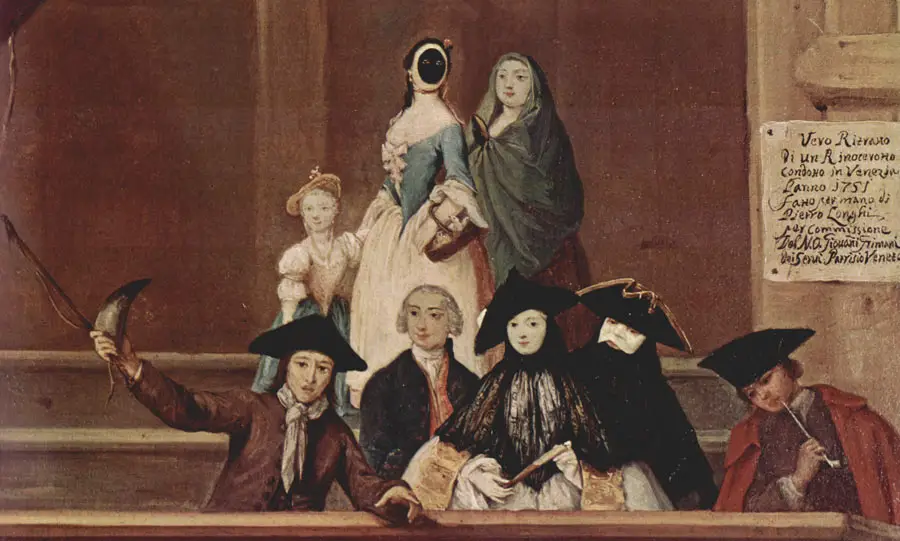| In Venice Today.com |
|
||
|
|
|||||||||||||||||||||||||||||||||||
|
|||||||||||||||||
Histoy of Venice CarnivalThe history of the Carnival of Venice Italy: dates, information, history, masks and rebirth of the Venice Carnival. |
|||||||||||||||||
 History of Venice Carnival - Venice Italy History of Venice Carnival - Venice ItalyMasks and headpieces of Carnival on "Clara, Il rinoceronte" (Pietro Longhi, 1751) Event from February 16th to March 5th 2019 The Venice Carnival is one of the most felt and experienced parties both by the Venetians and by the many visitors who arrive every year in the city from all over the world. It lasts 18 days and ends with the classic fat days, the culmination of the Venice Carnival. The program includes performances in Piazza San Marco, in the major theaters of the city, in the Venetian camps that offer different proposals and in the port suburbs that organizes night parties for the youngest. Even the mainland with Mestre, Marghera, and all neighboring countries, offer a rich program of events with shows and concerts. Go to the Venice Carnival Program 2019 - Carnival opening regatta: 17 February 2019, from 10.30 to 13.00, Rio di Canaregio, Three Arches Bridge and Guglie - Venice History of Venice Carnival The term derives from the Latin phrases carnem levare or carnem levamen that means "take off the meat", with reference to fat tuesday as the last possible day to have a Lucullian lunche before the usual food deprivations during the period of Lent. A festival therefore linked to Christian and Catholic worship seems, even if it is almost certain that tradition goes back to the Greek and Roman period and has been absorbed - like so many other social and political aspects of the ancient world - by the later Christian society. Suffice it to think of the Feast of Saturnalia, which was held in Rome from December 17 to 23 and which was characterized by a reversal of the social order in which the slaves became free, dine with their masters who also became their servants. And there was no lack of masks and disguises in divinity. The same suspension of the established social rules is found in the Venetian Carnival which was presented in historical documents starting from 1094, when in a document of the Doge Vitale Falier the term Carnival is reported and a show dedicated to public entertainment is mentioned. In the following years, citizens of every class crowded in the streets of Venice, almost always masked to get rid of any social convention. "Buongiorno siora maschera". It was the simple and equal greeting for everyone that citizens used in the city. Shortly after an edict of the Senate of the Republic declared holiday the period before Lent; in fact the Carnival lasted from December 26th until the day before Ash Wednesday, which became Shrove Tuesday. In these days it was possible to go around Venice in disguise and was allowed to put on the sedan the aristocratic power that assumed all the political offices. If we look at the date, in fact, 1296 precedes the Serrata del Maggior Consiglio in just one year, when the noble patricians excluded the people from the public administration. Moreover the distraction of the masses with public performances and the possibility of an outburst of discontent, through the consent of a temporary public derision of power, have always been a powerful weapon in the hands of those who exercise, and want to preserve, power. The exercise of this freedom, however, was not exempt from trespassing in the field of illegality - with muggings, robberies, harassment and rape - and so from February 22, 1339 the Senate decreed a night ban to circulate masked and in the following century, the 24 January 1458, even the prohibition to enter dressed as religious in sacred places came to prevent libertine acts with the nuns. In the same way, it was forbidden to bring weapons under the disguise and to exercise the prosituzione outside the free zones established in the city (like the famous Castelletto di Rialto) taking advantage of the mask; the penalty was the banning for 4 years from Venice after being publicly flogged in Piazza San Marco. The arrival of the French in the city in 1797, which decided with the Treaty of Campoformio the transfer of Venice to the Austrians (October 17, 1797) but not before having robbed all possible goods, determined the end of the Carnival and the ban on wearing masks in public; a decision taken in a climate in the city of strong aversion to the French rulers before, and to those of Austria after 18 January 1798. The revival of the Venice Carnival took place by decision of the City Council that from 1979 established the public festivities again, accompanied by a rich program of events that since then has never stopped attracting hundreds of thousands of visitors from all over the world to the city in every edition. |
|||||||||||||||||